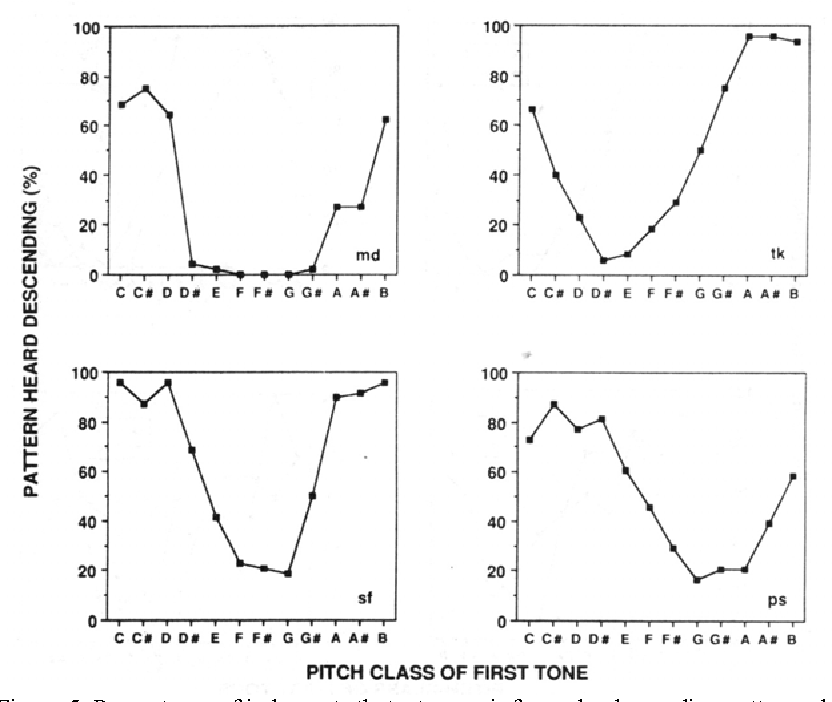DOWNLOAD TRITONE PARADOX
Music Perception , , 12, To further illustrate the differences between listeners in perception of the tritone paradox, the judgments of four more subjects are shown below. A regional difference in perception of the tritone paradox within the United States. For the first subject, pitch classes G and A stood at the top of the circle, but for the second subject, C and D stood in this position instead. Both human and animal experiments were conducted according to the ethical guidelines of the University of Maryland. The psychology of music, 3rd Edition, , , San Diego: 
| Uploader: | Kigar |
| Date Added: | 5 September 2004 |
| File Size: | 44.32 Mb |
| Operating Systems: | Windows NT/2000/XP/2003/2003/7/8/10 MacOS 10/X |
| Downloads: | 95470 |
| Price: | Free* [*Free Regsitration Required] |
To further illustrate the differences between listeners in perception of the tritone paradox, the judgments of four more subjects are shown below. The results supported my conjecture - the judgments of most subjects varied systematically depending on the positions of the tones along the pitch class circle: In addition, people who have spent considerable time in more than one geographical region sometimes produce mixed results.
Tritone paradox
Archives of Acoustics, tirtone, This is particularly surprising when the demonstration is played to a group of musicians who are all certain of their judgments. The perceived stimuli in the ambiguous pair were estimated from the neural responses by training a decoder on the biasing sequences and then applying the decoder to the neural response of the pair.
When one of these tone pairs is played such as C followed by F a listener might hear a descending pattern. Frequently when a Californian subject heard a pattern as ascending, a subject from the south of England heard the identical pattern as descending, and vice versa 4. Some studies have shown that people from different geographical regions perceive the tones differently. The dark grey areas indicate acceptable perceived pitches of the tones to still be heard according to the bias for the relative decoder.
Tritone Paradox
However, psychology of music researcher Diana Deutsch in discovered that when the judgments of individual listeners were considered separately, their judgments depended on the positions of the tones along the chromatic circle.
Abstract The context in which a stimulus occurs can influence its perception.
Music Perception, 3, Auditory illusions Paradoxes Tritones. Paradoxes of musical pitch.
Diana Deutsch's Audio Illusions : Deutsch's Tritone paradox
One group had grown up in California, and the other group had grown up in the south of England. It even appears that the way a person hears the Tritone Paradox is related, not only to tritoone geographical region in which he or she had grown up, but also to the regions in which his or her parents had grown up.
Music Perception, 12, The pitch class of a stimulus is encoded in the population response, via the various response properties of different neurons. Since this result is unexpected, given the standard decoder, we tested whether it holds for human subjects. The tones that are used to create the tritone paradox are so constructed that their note names C, CD and so on are clearly defined, but they are ambiguous with respect to which octave they are in.
For the first subject, pitch classes G and A stood at the top of the circle, but for the second subject, C and D stood in this position instead.
The PCA Principle Component Analysis decoder performed a linear dimensionality reduction, interpreting the stimuli as examples and the neurons as dimensions of the representation. The Tritone Paradox has another curious feature. Some further geographical correlates.
The bias-induced shift was 0. We study contextual effects in audition using the tritone paradox, where a pair of complex Shepard tones separated by half an octave can be perceived as ascending or descending. Frequently when a Californian subject heard a pattern as ascending, a subject from the south of England heard the identical pattern as descending, and vice versa.
Tritone Paradox - Wolfram Demonstrations Project
Perception and Psychophysics, 60, Further, we paaradox pitch comparison sequences in the psychophysical studies. The classical decoder chooses the smaller angle between two Shepard tones on the pitch circle as the direction of pitch change, i. Using human psychophysics, we provide evidence that this shift in pitch is present in active human perception as well.
Music Perception, 8, Whether the tones appear to move up or down in pitch depends entirely on the mind of the listener. All stimuli were composed of sequences of Shepard tones Shepard


Комментарии
Отправить комментарий